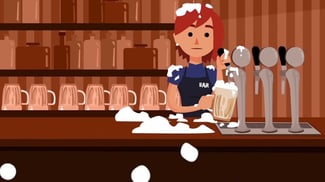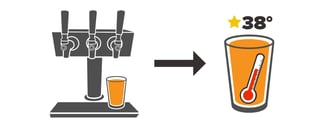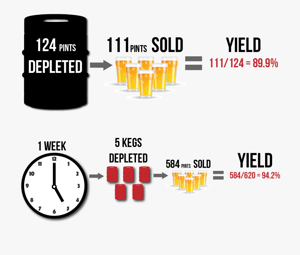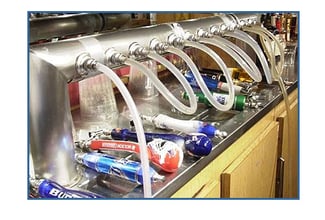Recently, one of our most successful clients has been dealing with an issue regarding their draft beer products. This bar has an overall accountability score of 98%, but their draft beer products consistently fail to perform at this level. When we started considering ways to improve their draft beer numbers, it became clear that they needed to service their system.
This is actually a logical explanation given the fact that this bar is only missing 2% of products in other categories (liquor, wine and bottled beer). In a situation like this, it is unlikely (although not impossible) that the staff is doing something different when pouring draft beers that is causing a higher percentage of these products to go missing. That being said, it was impossible to evaluate staff accountability on draft beer products until we were confident their draft system was working properly.
What Causes Draft Beer Products to Perform Poorly?
 There are two reasons why you may be wasting too much draft beer:
There are two reasons why you may be wasting too much draft beer:
- A draft beer system that is poorly set up or isn’t functioning properly
- The actions of your bartenders (spilling beer, wasting beer due to improper pouring practices, or failing to ring up every beer that has been poured)
While the inventory data generated from our audits will show you exactly how much beer you’re missing, it can be challenging to pinpoint the precise cause of the issue, especially if your draft beer system isn’t performing well. If your system is wasting a lot of beer, it’s impossible to hold your bartenders accountable. Your accountability and your draft beer system yields work together, and it’s difficult to separate one from the other.
Therefore, the first step in the process is to make sure your draft system is working correctly. Once you address any issues with draft system performance, you can take steps to improve the accountability of your bartenders (if this is necessary). In this specific situation with our high-performing client, their staff has great accountability. As a result, it became easy to determine the problem was being caused by their draft beer system.
Your Keg Yield Is Always Impacted by Natural Waste
Draft beer is unique because we always expect a certain amount of lost product. With other categories (liquor, wine and bottled beer), we can reasonably expect to aim for 100% of product poured being sold because there is no natural waste. Therefore, you’re not losing any of these products as an inevitable part of doing business the way you always lose a small portion of beer in each keg.
There are three major issues which cause natural waste in draft beer products:
 Temperature – Having cold beer in your kegs and a cold system all the way to the tap is the most important element of a properly functioning draft beer system. If you don’t have cold enough temperatures all the way through the system, you’re going to have a big problem with natural waste.
Temperature – Having cold beer in your kegs and a cold system all the way to the tap is the most important element of a properly functioning draft beer system. If you don’t have cold enough temperatures all the way through the system, you’re going to have a big problem with natural waste.- Pressure – Different beers, lines and setups require different pressure. Ideally, your system has the ability to adjust pressure on individual lines instead of by zones (where multiple lines are grouped together). This is the best way to ensure every line maintains the right pressure at all times.
Keep in mind that mismanaging and overcorrecting your pressure causes as many problems as it solves. Therefore, this isn’t something that should be done by your bartenders. It should be determined carefully by the owner or manager and once your pressure levels are set, they should be left as is. - Human error – Setting the pressure levels improperly, failing to make sure kegs are rested in the cooler before they get tapped, and tapping the wrong keg are all ways your staff can make a mistake that will impact the performance of your draft beer system.
What Is a Reasonable Keg Yield to Expect with a Properly Functioning Draft Beer System?
Based on thousands of inventory audits across 25 states, we’ve found that bars should be able to consistently get a 95% keg yield. In other words, natural waste shouldn’t exceed 5% of your overall yield.
Some factors that might affect your keg yield include:
- Sales volume – It’s common to waste a beer or two at the start of the day as part of the process of getting your taps running. The higher your sales volume, the less those wasted beers at the start of the day will impact your keg yield.
- Line length – In general, the longer your lines are from the kegs to the taps, the worse your keg yield will be.
- FOBs – FOB (foam on beer) devices can help improve the keg yield of draft systems with long lines.
- Glycol – You always want to use a glycol cooling system, especially if you have a long draw draft beer system. Glycol cooling systems are the most effective way to maintain a proper temperature for your draft system.
 Keg sizes – Different keg sizes can affect the performance of your draft beer system. Smaller kegs must be changed out more frequently, which will negatively impact your keg yield. We found that sixtel kegs are especially problematic in this way.
Keg sizes – Different keg sizes can affect the performance of your draft beer system. Smaller kegs must be changed out more frequently, which will negatively impact your keg yield. We found that sixtel kegs are especially problematic in this way.- Rotations – Replacing an empty keg with another keg of the same type of beer doesn’t result in very much waste. However, you naturally waste more beer when you replace an empty keg with a different type of beer because you have to bleed the lines and the new keg may require a different pressure level. Therefore, frequent tap rotations tend to hurt your keg yield.
6 Steps to Take When Evaluating the Performance of Your Draft Beer System
The following process will help you determine whether you may need to service your draft beer system in order to improve the performance of these products:
 Measure your keg yield – Gathering data is always the first place to start. You measure your keg yield by looking at your sales for each keg. There’s 1984 ounces of beer in a full keg. If you use a 14.5-ounce pouring assumption with a 16-ounce glass, you want to see how many 14.5 ounce portions you got out of each keg and then divide this figure by 1984 to determine the percentage yield.
Measure your keg yield – Gathering data is always the first place to start. You measure your keg yield by looking at your sales for each keg. There’s 1984 ounces of beer in a full keg. If you use a 14.5-ounce pouring assumption with a 16-ounce glass, you want to see how many 14.5 ounce portions you got out of each keg and then divide this figure by 1984 to determine the percentage yield.
As we mentioned before, you’re never going to have 100% keg yield due to natural waste, but it is reasonable to expect your yield to be around 95%.- Evaluate the cost of missing beer – If your keg yield is 90%, then you know approximately 5% of this loss is unexpected. You want to look at this additional loss over the 5% caused by natural waste and see how much it’s costing your business per week. Ideally, you want to determine this cost line by line.
- Compare lines – If one line is yielding 95% and another is yielding 75%, there’s probably a problem with that specific line. When you have one line working perfectly, it implies the system can function properly under the right conditions. Therefore, you need to figure out what’s going on with the specific lines that are performing poorly.
- Experiment with creative solutions – One of our clients was having a problem with a specific line on their draft system and couldn’t get it to work properly, even after reinstalling the entire line. We suggested that they move their cider to this line since cider is less foamy and as a result, tends to waste less product. This “cider hack” solved the problem, allowing the problematic line to function properly without the need to replace the system.
The main takeaway here is that sometimes you can get creative with your troubleshooting solutions in order to achieve your desired outcome. Managing a draft beer system can be complicated and at times require this type of trial and error process to optimize its performance.  Compare yields on cleaning and non-cleaning weeks – Most bars have their lines cleaned every other week. If you take inventory on a weekly basis, you should be able to see a difference in yield between the weeks your lines are being cleaned and the weeks they aren’t being cleaned (more beer should be wasted on cleaning weeks). You can also ask your cleaner to measure how much beer is being wasted to see how this is impacting your keg yield. Knowing this measurement will help prevent you from factoring in the effect of line cleaning with your missing beer.
Compare yields on cleaning and non-cleaning weeks – Most bars have their lines cleaned every other week. If you take inventory on a weekly basis, you should be able to see a difference in yield between the weeks your lines are being cleaned and the weeks they aren’t being cleaned (more beer should be wasted on cleaning weeks). You can also ask your cleaner to measure how much beer is being wasted to see how this is impacting your keg yield. Knowing this measurement will help prevent you from factoring in the effect of line cleaning with your missing beer.- Ask your vendors for help – Once you’ve performed all of these calculations, you need to see how much it’s going to cost to have your draft beer system serviced. Often, your vendors can help you choose the best service providers. If you point out that you’re having trouble getting beer out of your vendor’s kegs, they will usually make an effort to help you fix the problem so that you continue buying beer from them.
Precise Data Is Crucial to Determine Whether You Need to Service Your Draft Beer System
You need precise data to pinpoint the cause of the problem you’re experiencing with your draft beer performance. The best way to acquire this data is to use a sophisticated inventory system that compares what you’re selling vs. what you’re pouring. At Bar-i, we provide this data as part of our weekly inventory reports. You can use this information to evaluate your keg yields on a weekly basis, which will help you figure out where the problem is and whether it is system-wide, or located in individual lines or kegs.
A cheap way to start tracking this data is to use our Keg Performance Checker worksheet. We recommend that you use one log sheet per draft line, and then record how your draft lines are working each day. This is a very inexpensive, simple way to gather data and figure out if specific lines are more problematic than others.
Many bars we work with initially experience a poor keg yield and think it’s being caused by the draft system. This is sometimes the cause of the problem, but not always. The only way to know for sure is to gather the data necessary to determine how well every line on your draft system is performing.
If you’re trying to optimize your business, you need to get your draft beer system working correctly before you can realistically have success improving the performance of your draft beer products. System-created waste provides a very effective smokescreen for your employees, making it impossible to determine the extent to which they aren’t being accountable.
Once you know for certain that your draft system is working properly or you’ve corrected any issues with the system, you can more confidently determine that poor performance is related to staff accountability. Most bars don’t need to spend thousands of dollars getting a new draft beer system. By collecting the right data, you can usually identify ways to optimize the performance of your current system to improve your keg yield. You can then take any steps necessary to improve staff accountability so that you experience optimal performance for all of your draft beer products.
If you’d like to learn more about how Bar-i can help you streamline your operations and maximize profits, please contact us today to schedule a free consultation. We serve bars and restaurants nationwide from our offices in Denver, Colorado.



-1.png)